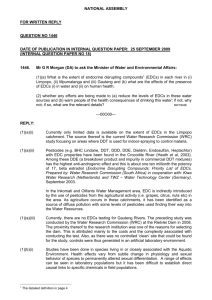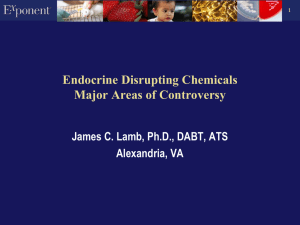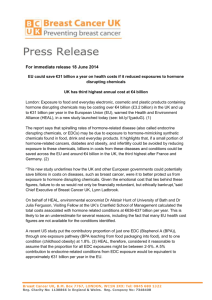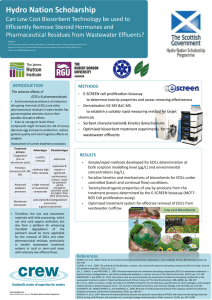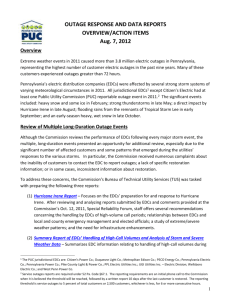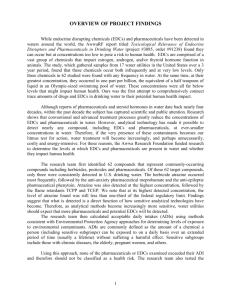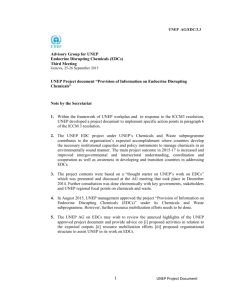Supporting Information On Endocrine
advertisement
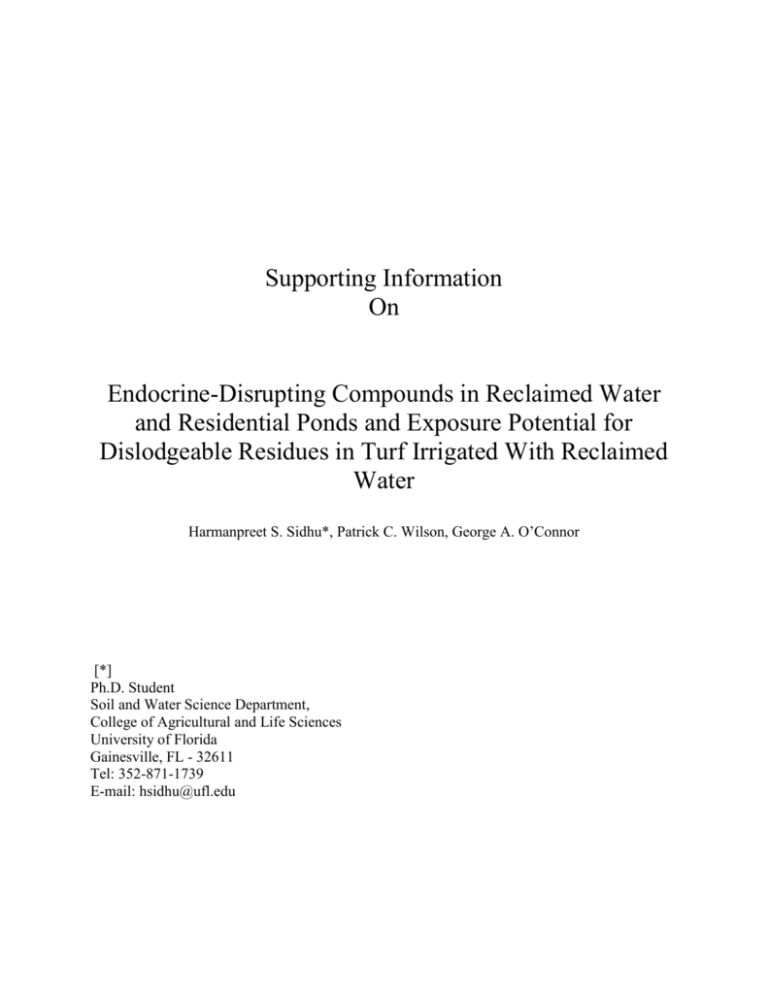
Supporting Information On Endocrine-Disrupting Compounds in Reclaimed Water and Residential Ponds and Exposure Potential for Dislodgeable Residues in Turf Irrigated With Reclaimed Water Harmanpreet S. Sidhu*, Patrick C. Wilson, George A. O’Connor [*] Ph.D. Student Soil and Water Science Department, College of Agricultural and Life Sciences University of Florida Gainesville, FL - 32611 Tel: 352-871-1739 E-mail: hsidhu@ufl.edu 1. Results 1.1. Water Samples: Table.S1. Detection concentrations (ng) and detection frequencies of EDCs (%) and coprostanol in RW (n=28) and pond (n=64) samples. Chemical Maximum/Minimum Concentration Frequency of (Median) detection in RW (%) RW Ponds E1 E2 EE2 BPA NP Coprostanol 47/< 5 (26) 51/< 7.3 (26) 45/< 7.3 (31) 138/< 7.7 (57) 52/< 4.9 (31) 67/<5.7 (29) 37/ < 5(<10) 34/ 7.3 (<10) 58/< 7.3(<10) 303/< 7.7 (28) 46/< 4.9 (<10) 61/< 5.7 (<15) Frequency of detection in ponds (%) 72 61 83 96 73 90 66 33 64 76 37 75 1.2. BPA Variability BPA concentrations were more variable than other EDCs in both RW and ponds. Higher variability in BPA concentrations is in agreement with literature on the occurrence and fate of BPA (Belfroid et al., 2002), and may be attributed to variable initial concentrations in wastewater due to variable use in households. BPA masses (St. Dev. 43) were more variable among replicates than masses of the other EDCs. 1.3. EDCs dislodged versus EDCs on grass Fig S1. Percent of EDCs dislodged from grass surface with time (hours). 2. Comparison of EDC concentrations obtained in water samples to literature: Table S2. Median concentrations of EDCs obtained from the study of RW and concentrations reported in literature. Chemical E1 E2 EE2 BPA NP Median concentration found (ng/L) 26 26* 31* 57 31 Number of Samples Median concentration reported (ng/L) 104 185 104 104 50 <10 (Ying et al., 2002a) <14 (Ying et al., 2002a) <10 (Ying et al., 2002a) 350-400 (Mohapatra et al., 2011; Spengler et al., 2001) 400-500 (Ying et al., 2002b) 3. Potential Exposure to Dislodgeable Residues Maximum EDC masses dislodged (corrected for percent recoveries) extrapolated to an area of 100 m2 were used to calculate the amount of EDC that a child might be exposed to based on a worst-case scenario (whole body of a 3 year old child is exposed to all the EDC mass available in 100 m2 of contaminated turf immediately after irrigation). Maximum masses dislodged from an area of 844 cm2 via the drag sled method were 33 ng (E1), 51 ng (E2), 25 ng (EE2), 296 ng (BPA) and 323 ng (NP). Masses corrected for percent recoveries are 45 ng (E1), 72 ng (E2), 33 ng (EE2), 370 ng (BPA) and 403 ng (NP). Values extrapolated to a household turf grass area of 100 m2, yields 53 µg (E1), 85 µg (E2), 39 µg (EE2), 438 µg (BPA) and 478 µg (NP). Assume that a 3-year old child weighing 13.6 kg plays on 100 m2 of contaminated turf (immediately after RW application) for an hour (USEPA, 2011). Based on the very low concentrations of EDCs (few µg/100 m2), the child is likely to come in contact with very small amounts of EDCs. For a 100 m2 lawn, the mass of upper 0.01 cm of a soil with bulk density of 1.33 g/cm3 is around 133 kg and mass of turf grass (above ground portion) is around 15 kg. Now if we assume that the 2.5 cm of RW applied to this 100 m2 lawn contains 1000 ng/L of EDC and that the irrigation is uniform, the percent of 1000 ng/L of EDC that a child might come in contact with at a given time, would be on the order of 10-6% wt/wt basis. If we further assume that during an hour the child comes in contact with the contaminated turf a 10000 times and the contact with EDC is additive, the percent of EDC he/she will contact would be on the order of 10-2%. Considering that only a portion of total EDCs in the contaminated lawn are dislodged, the percent EDCs that come in contact with the child will be less and the EDCs retained on the child’s body will be even smaller. The actual exposure from dislodgeable EDCs is further reduced by the fact that it is not likely that the child plays in just irrigated (wet) turf. Therefore as a worst case scenario, we assume that the entire body of the child comes in contact with the entire 100 m2 area of turfgrass and 1% of the dislodged EDC present in the lawn is retained on the child’s body. Thus, the total EDC mass to which the child could be dermally exposed is 530 ng (E1), 850 ng (E2), 390 ng (EE2), 4380 ng (BPA) and 4780 ng (NP). Further, assume that 5% of the adhering EDC masses are absorbed into the child’s body following 1 hour of exposure (Monteiro-Riviere et al., 2000; Demierre et al., 2012; Kao and Hall, 1987). This assumption yields total dermally internalized dislodgeable masses of EDCs of 27 ng (E1), 43 ng (E2), 20 ng (EE2), 219 ng (BPA) and 239 ng (NP). The child may also ingest 100 mg/day (around 4 mg/ 1hour) of the soil and dust (USEPA, 2011) via licking contaminated grass and/or hands/ fingers. If 0.001% of the ingested material is EDC (mass of EDCs is µg/ several hundred kg of turf, negligible EDC volatilization and there is no direct ingestion of grass or the soil below grass), 40 ng of each EDC will be ingested. NP has an additional route of possible exposure- inhalation. On an average, a 3 year old child inhales 10.1 m3 of air/day (USEPA, 2011) or 0.5 m3/ hour. To account for rapid breathing during playing assume that the child will inhale 1 m3 of air. Assuming NP concentration of 70 ng/m3 in the air surrounding the lawn (Dachs et al., 1999; Van Ry et al., 2000), the child would inhale 70 ng of NP through air. Thus, the total internalized dose of EDCs becomes 67 ng (E1), 83 ng (E2), 60 ng (EE2), 259 ng (BPA) and 349 ng (NP), per 13.6 kg body weight or 5 ng (E1), 6 ng (E2), 4.5 ng (EE2), 19 ng (BPA), and 26 ng (NP) per kg body weight. References: Belfroid AC, Van Velzen M, Van der Horst B, Vethaak D (2002). Occurrence of bisphenol A in surface water and uptake in fish: evaluation of field measurements. Chemosphere. 49:97–103. Dachs J, Van Ry D, Eisenreich S (1999). Occurrence of estrogenic nonylphenols in the urban and costal atmosphere of the lower Hudson River estuary. Environ. Sci. Technol. 33:2676-2679. Demierre AL, Peter R, Oberli A, Bourqui-Pittet M (2012). Dermal penetration of bisphenol A in human skin contributes marginally to total exposure. Toxicol Lett. 213:305-308. Kao J, Hall J (1987). Skin absorption and cutaneous first pass metabolism of topical steroids: in vitro studies with mouse skin in organ culture. J. Pharmacol. Experi. Therap. 241:482. Mohapatra DP, Brar SK, Tyagi RD, Surampalli RY (2011). Occurrence of bisphenol A in wastewater and wastewater sludge of CUQ treatment plant. J. Xenobiotics. 1:9-16. Monteiro-Riviere NA, Van Miller JP, Simon G, Joiner RL, Brooks JD, Riviere JE (2000). Comparative in vitro percutaneous absorption of nonylphenol and nonylphenol ethoxylates (NPE-4 and NPE-9) through human, porcine and rat skin. Toxicol. Ind. Health. 6, 49-57. Spengler P, Korner W, Metzger JW (2001). Substances with estrogenic activity in effluents of sewage treatment plants in southwestern Germany. 1. Chemical analysis. Environ. Toxicol. Chem. 20:2133-2141. USEPA (2011). Exposure Factors Handbook. EPA/600/R-090/052F. U.S. Environment Protection Agency, United States. Office of Research and Development, Washington, D.C. Van Ry D, Dachs J, Gigliotti C, Brunciak P, Nelson E, Eisenreich S (2000). Atmospheric seasonal trends and environmental fate of alkylphenols in the lower Hudson River estuary. Environ. Sci. Technol. 34:2410-2417. Ying GG, Kookanaa RS, Rub YJ (2002a). Occurrence and fate of hormone steroids in the environment. Environ. International. 28:545– 551. Ying GG, Williams B, Kookana RS (2002b). Environmental fate of alkylphenols and alkylphenol ethoxylates – a review. Environ. International. 28:215-226.

